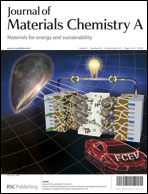Indolocarbazoles end-capped with diketopyrrolopyrroles: impact of regioisomerism on the solid-state properties and the performance of solution-processed bulk heterojunction solar cells†
Abstract
Two regioisomeric indolo[3,2-b]carbazoles end-substituted with diketopyrrolopyrrole dyes (3,9-TDPPIC and 2,8-TDPPIC) were synthesized, and their solid-state properties and performance as donor materials for bulk heterojunction solar cells using [6,6]-phenyl-C61-butyric acid methyl ester (PCBM) as an acceptor material were evaluated. Depending on the regiochemistry of backbone linkages (3,9- or 2,8-linkage), these two compounds showed quite different solid-state aggregation behaviors (crystalline versus amorphous), leading to a significant difference in the degree of phase separation upon blending with PCBM. As a result, a distinct effect of thermal annealing on the device parameters of solar cells (Voc and Jsc) was observed for these compounds although both the devices showed almost the same power conversion efficiency (PCE) of ca. 0.7% with thermal annealing at 130 °C. For 3,9-TDPPIC, the highest PCE of 1.8% was achieved by further optimization of the device.


 Please wait while we load your content...
Please wait while we load your content...